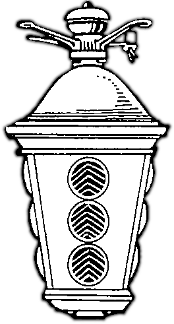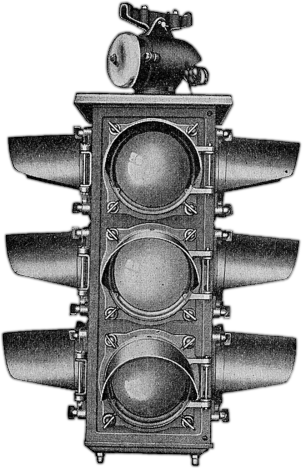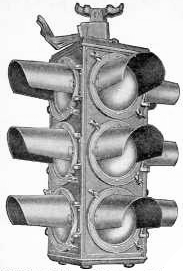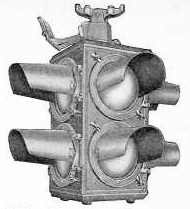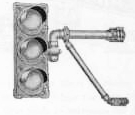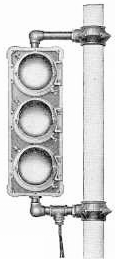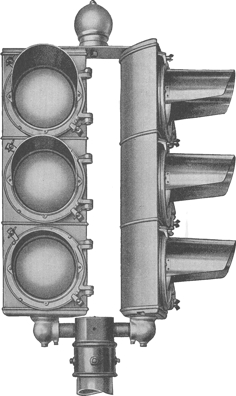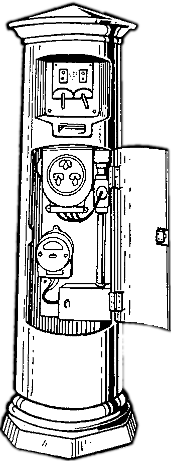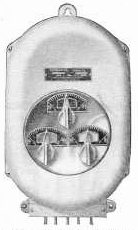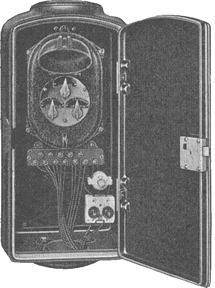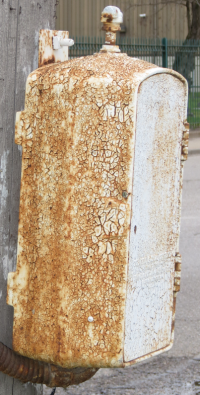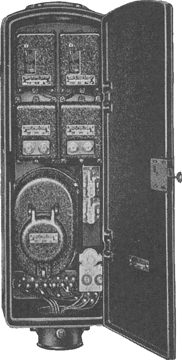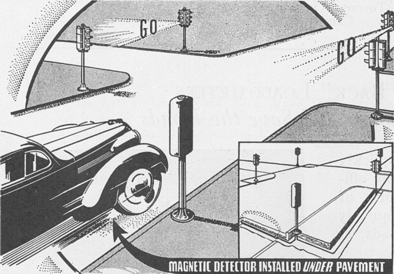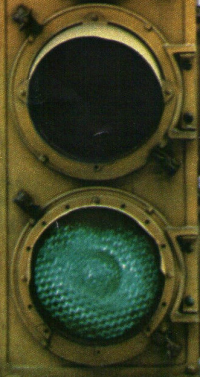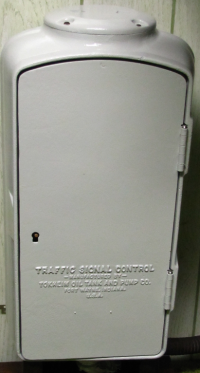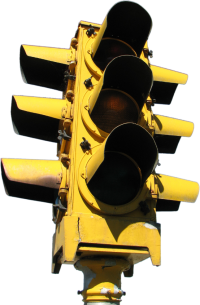Tokheim
Contents
- 1 Corporate History and Overview
- 2 Traffic Signals
- 2.1 Four Ways
- 2.2 Adjustables
- 2.2.1 Cut 1310 - One-Way, Post-Type, Traffic Control Signal
- 2.2.2 Cut 1400 - Horizontal Adjustable Post Bracket, Traffic Control Signal
- 2.2.3 Cut 1406 - One-Way, Vertical-Bracket Type, Traffic Control Signal
- 2.2.4 Cut 1410 - Vertical Adjustable Post Bracket, Traffic Control Signal
- 2.2.5 Sectional Signals
- 3 Pedestrian Signals
- 4 Informational Signals and Signs
- 5 Lenses
- 6 Controllers
- 7 Hardware
- 8 Miscellaneous Images
- 9 Relevant Patents
- 10 References
Corporate History and Overview
Following the February 1898 design of a gas pump by John J. Tokheim the Tokheim Manufacturing Company was incorporated in Cedar Rapids, Iowa in 1901. In 1918 employees of the Wayne company set out on their own, purchasing Tokheim and reincorporating it as the Tokheim Oil Tank and Pump Company, moving to Fort Wayne, Indiana in the old Wayne Spoke and Bending Company factory. In April 1926 they acquired the Signaphore company, also located in Fort Wayne, and formed the Tokheim Traffic Signal Division - although such branding has not been seen on their products, instead retaining the TOT&PCo. nomenclature. This acquisition brought along J. N. Paul of Automatic Signal Co. and Ruben E. Bechtold, from Signaphore. They would greatly develop and expand the Signaphore line into the modern traffic signal as well as introduce new controllers. By 1937 their interest in the product line waned and on January 8th, 1938 the transition of their signal interests both in design and manufacturing to Automatic Signal of East Norwalk, Connecticut, took place, along with pioneering traffic engineer Reuben E. Bechtold. [1]
Traffic Signals
When the Signaphore line was acquired they were producing novel 4-way traffic signal standards that appeared much like a round bodied gas pump with a traffic light on top. Like many manufacturers of the day they produced signals out of both aluminum and copper, later switching to all aluminum. Quite popular locally, they attracted the attention of Detroit, who requested pole-mount versions of the signal. Adjustable traffic signals would follow, and their market spread throughout the midwest including such cities as Cleveland, Chicago, and Detroit. It has been said they entered the international market too, however little is know of that.[1]
All Post-Signaphore Tokheim signals were designed with several characteristics:
- All bodies are of cast aluminum
- Felt gaskets are used on the lense and door
- Doors are portholes held in place with two L-clamps and wingnuts
- All visors were cutaways with 8" length
- Reflectors are thick glass with an electrolytic copper plating
- Reflectors are held in a pan and mounted to the signal body
- Sockets are a porcelain Leviton wing style
- Wiring is done with rubber wire
- Lamps are 50-Watt household or 60-Watt traffic bulbs
Tokheim signals also had several build options available as documented in the hardware section.
Four Ways
Signaphore Signals
For a brief period of time following the acquisition of Signaphore, Tokheim produced an intricate appearing four-way signal available in both aerial (as shown) and post mount versions. It is believed this type only existed through 1925.
Early Tokheim Signals
 In 1926 Tokheim begin to advertise traffic signals of a revised design that had the same basic design that would continue through the end of their product line. The primary difference in these signals was the design of the porthole door. In the early signals it was a door hinged to the body while held down with four thumbscrews protruding through ears on the door. Later signals would simplify this door design, remaining hinged but changing it to a full circle (removing the thumbscrew ears) and locking it down via only two body mounted studs with springs, L-brackets, and wingnuts mounted to the upper left and lower right of the door - although the body casting and door castings would contain provisions for four hold down tabs. The visors maintain the same profile, however the earlier ones appear to be cast and either integral or bolted to the door.
In 1926 Tokheim begin to advertise traffic signals of a revised design that had the same basic design that would continue through the end of their product line. The primary difference in these signals was the design of the porthole door. In the early signals it was a door hinged to the body while held down with four thumbscrews protruding through ears on the door. Later signals would simplify this door design, remaining hinged but changing it to a full circle (removing the thumbscrew ears) and locking it down via only two body mounted studs with springs, L-brackets, and wingnuts mounted to the upper left and lower right of the door - although the body casting and door castings would contain provisions for four hold down tabs. The visors maintain the same profile, however the earlier ones appear to be cast and either integral or bolted to the door.
Cut 1110 - Aerial Traffic Control Signal
Cut 1112 - Dual Traffic Control Signal
Later Tokheim Signals
Cut 1200 - Four-Way Aerial Traffic Control Signal
Figure: Tokheim 1200 Signal. [Image by LC]
Cut 1260 - Four-Way, Two Color, Aerial Traffic Control Signal
No Yellow/Caution Lens
Figure: Tokheim 1260 Signal. [Image by LC]
Cut 1300 - Four-Way, Post-Type, Traffic Control Signal
Figure: Tokheim 1300 Signal. [Image by LC]
Sectional Signals
At some time, 4-way sectional heads were also made.
Adjustables
Cut 1310 - One-Way, Post-Type, Traffic Control Signal
Also available in two to five way clusters. Solid Body
Figure: Tokheim 1310 Signal. [Image by LC]
Cut 1400 - Horizontal Adjustable Post Bracket, Traffic Control Signal
Figure: Tokheim 1400 Signal. [Image by LC]
Cut 1406 - One-Way, Vertical-Bracket Type, Traffic Control Signal
Also available in two to four way clusters. Solid Body
Figure: Tokheim 1406 Signal. [Image by LC]
Cut 1410 - Vertical Adjustable Post Bracket, Traffic Control Signal
Figure: Tokheim 1410 Signal. [Image by LC]
Sectional Signals
This is a sectional signal head made by Tokheim.
Figure: Tokheim sectional head. [Image by LC]
Pedestrian Signals
Vehicle Heads (Round)
Tokheim did not manufacture any pedestrian signals.
Vehicle Heads (Square Door Adapters)
Tokheim did not manufacture any pedestrian signals.
Pedestrian/Sign Heads (Rectangular)
Tokheim did not manufacture any pedestrian signals.
Informational Signals and Signs
describe models, variations [delete] includes "box signs," "case signs," and Ped Heads with special [non-ped] lenses.
Lenses
Vehicular
Lenses are 8 3/8" dia. with a 90° diffusing pattern. Command lenses are optional, with embossed letters two inches high, and a baked enamel finish.
Pedestrian
describe models, variations
Worded
describe models, variations
Symbols
describe models, variations
Special
describe models, variations
Controllers
Controllers were individually settable for the Red, Yellow, and Green phases. Stop and Go could be set for anywhere from 15 sec. to 3 minutes. The clearance, yellow, could be set from two seconds to seven[?]
Signaphore Controllers
The early controllers were either inherited from Signaphore or developed shortly thereafter. Not surprisingly, the early units were housed in a cast iron tube resembling the base of a gasoline pump.
seconds.
Cut 2000 - Chronoplan
Not a controller in itself, but the Tokheim guide on installation and setup of a traffic controller system utilizing a Chronolizer and several 1500 Timer modules. Improvements of up to 94% over the synchronized system and 43% over the staggered controller systems were guaranteed for a car doing the speed limit.
Chronolizer - Central Controller
This was a device attached to a series of 1500 timers to control a full roadway of signals in interoperation and coordination. It would set the cycle period for each individual controller which still had independent control over the timing of its red/[amber]/green split times. More than 1000 of these systems were reported in operation by 1928, reportedly improving the average speed of traffic flow "by 94% over a synchronized system or 43% over a stagger system."
Cut 1500 - Traffic Signal Timer
Intoduced in 1925, the model 1500 was a local timer for controlling traffic signals.
Figure: Tokheim 1500 Signal Timer. [Image by LC]
Cut 1820 - Automatic Traffic Signal Control
The model 1820 was essentially a 1500 timer and associated circuitry in a cabinet to allow isolated operation of a single signal or intersection.
Figure: Tokheim 1820 Signal Controller. [Image by LC]
Cabinets
Standard Controller Cabinet
There were a few variations of Tokheim cabinets used for traffic signal controllers. It is believed this unit is the most popular used with controllers such as the Cut 1820. Built out of a thick cast iron it was shallow and narrow like a large flasher box but tall like typical electromechanical controller cabinets. The lock is a standard skeleton key style with a security pin for the tip of the key. The cabinet may be accessed from the bottom or top, interchangeable endplates with threaded inserts were bolted to the signal from the inside. They could be pedestal mounted, with a change in bottom plate, or pole mounted with the addition of bracket strap plates attached to the back.
This model of cabinet underwent several minor revisions in its life. The markings on the door varied from: TRAFFIC SIGNAL CONTROL -MANUFACTURED BY- TOKHEIM OIL TANK AND PUMP CO. FORT WAYNE, INDIANA. U.S.A.
and
[insert other cabinet writing]
In addition, the ID plate varied from one emphasizing the traffic signal division
to one emphasizing the tank & pump corporate name.
.
Magnetic Detector
Part of the later signal line upgrades included early magnetic detectors for vehicle-actuation. Following is an example of the controller with magnetic detection modules and a marketing image of an intersection configured as such.
Figure: Tokheim magnetic detectors. [Image by LC]
Hardware
Tokheim had several modification kits that could be installed on the standard Cut traffic signals. These were used primarily on the 4-way signals.
- Blank covers were available as an option on one to three sides of a light.
- Angled door adapters were available in offsets of 15°, 30°, or 45°.
- The standard wire entrance hanger could be supplemented with a Traffic Bell that would ring during the amber change period.
- Possibly a downlight or bell mount bottom cover was available.
- In the post-Signaphore era it is believed Tokheim made only one kind of visor, a rolled aluminum sheet cap with rivited on brass or steel triangular tabs. This same visor was available with a perforated lip in place of the triangular tabs allowing rudimentary use as an adjustable, view limiting device. In the accompanying photo, used in a print advertisement for an oil company illustrates the standard visor (on the amber light) and the adjustable visor (on the green aspect.)
.
Miscellaneous Images
.
Relevant Patents
Inventor Company Number Date, Filed Date, Issued Desc Link
R. E. BECHTOLD Tokheim Oil Tank and Pump Company 1926833 26-Apr-26 12-Sep-33 Tokheim Signal Controller http://www.google.com/patents?id=rDpCAAAAEBAJ
R. E. BECHTOLD Tokheim Oil Tank and Pump Company 1951816 31-Jul-28 20-Mar-34 Synchronized Controller System http://www.google.com/patents?id=7JZXAAAAEBAJ
References
[1] Back to the Future Tokheim, Bob Lee, 1993, ISBN 0-9638220-0-4


